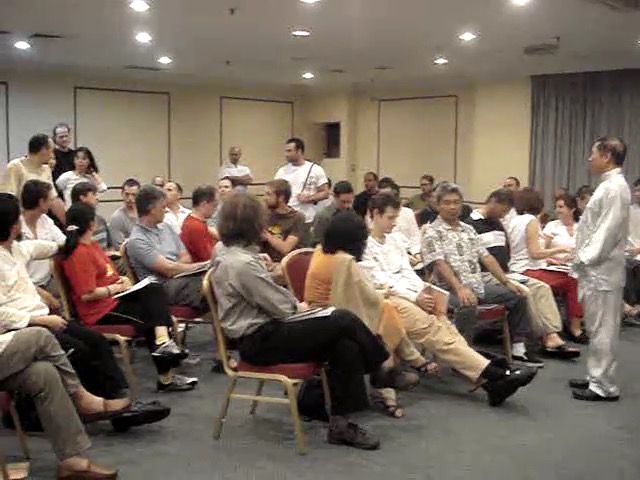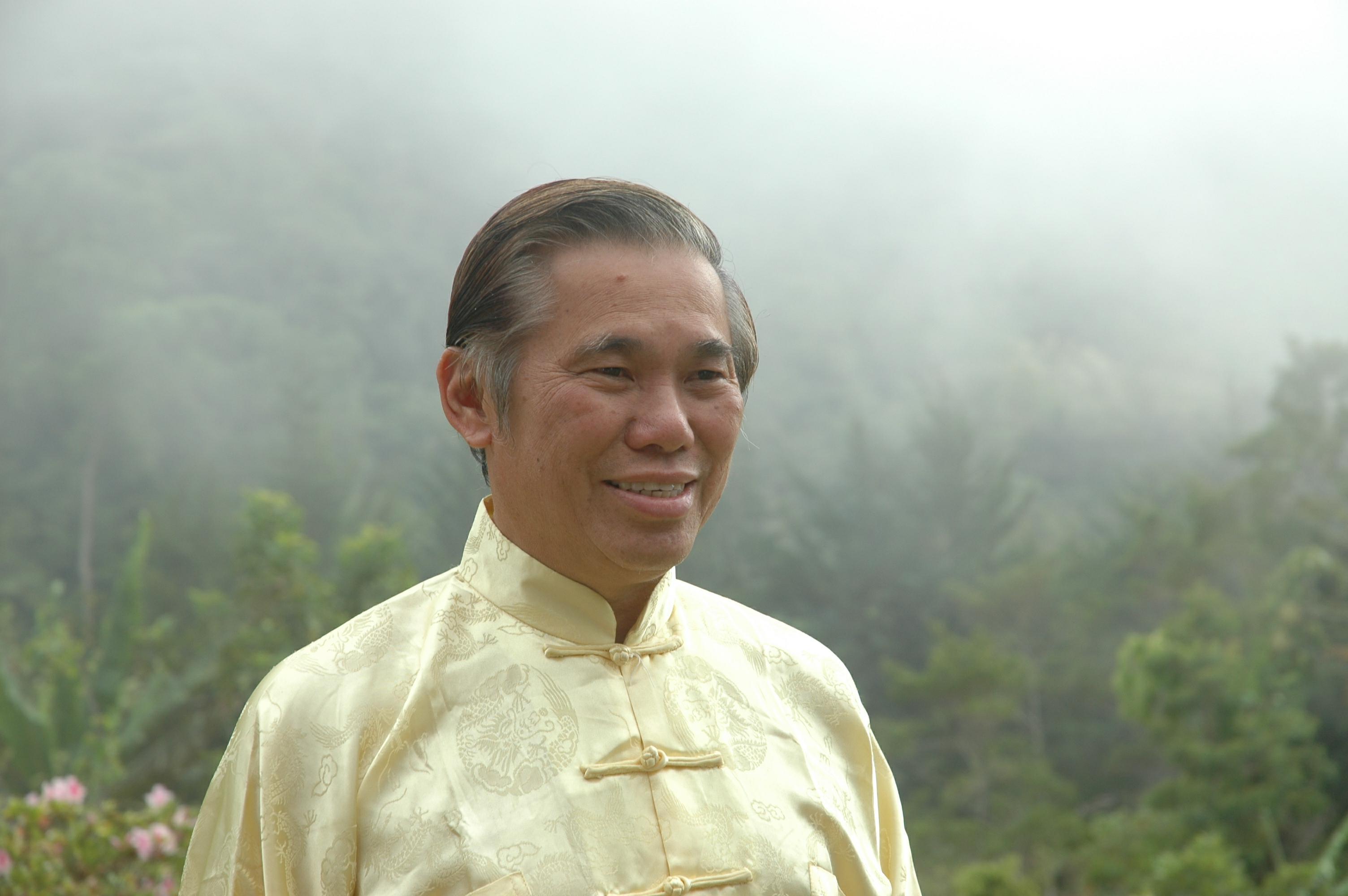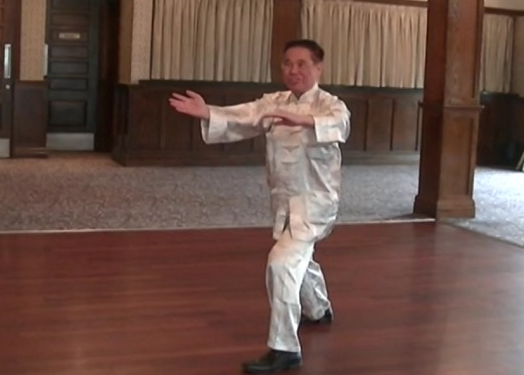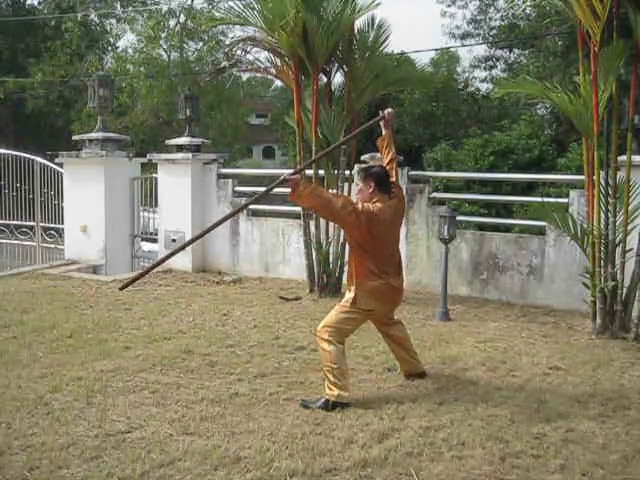SELECTION OF QUESTIONS AND ANSWERS
AUGUST 2020 PART 1

A Chi Kung Healing class.
Question 1
What is the difference between practicing chi kung and performing chi kung healing?
— Angel, Spain
Answer
The difference is that a chi kung practitioner practices his own chi kung, but a chi kung healer performs chi kung on a patient.
In our case, all those who attended the Chi Kung Healing Course practice chi kung. In other words, when they are successful in using chi kung healing, they are both chi kung healers and chi kung practitioners. We in Shaolin Wahnam believe that a chi kung healer must first be a good chi kung practitioner. He must know what he is doing.
A chi kung healer is not necessarily a better chi kung practitioner. We have many chi kung practitioners who are very good at their art, but they may not be interested in healing.
I would also like to mention that genuine chi kung is rare today. Genuine, high level chi kung is rarer still. Most chi kung practitioners practice gentle physical exercise, and many chi kung healers use physical exercise as treatment without any energy work.
Question 2
I did a little search on your website. In a Q & A, I found this passage:
"Three of the manuscripts I have started many years ago but are unfinished are 'The Wisdom of the Heart Sutra', 'The Diamond Sutra' and my autobiography which I have tentatively entitled 'The Way of the Master'.
The Heart Sutra is a very concise work, consisting only about 162 words in Chinese, yet it explains the whole essence of Mahayana Buddhism. The Diamond Sutra is a fantastic classic recording the Buddha's teaching on the Great Void, which in modern terms may be translated as Form and Energy. In my autobiography I describe my experiences in learning and teaching our Shaolin Wahnam arts, including interesting stories of Uncle Righteousness and Sifu Ho Fatt Nam.
In addition, I shall write some books on the I Ching, the Tao Te Ching, chi kung as practiced by past masters, as well as combat applications of Shaolin Kungfu and Taijiquan. The main reason why I have not published my completed manuscripts, continued my unfinished manuscripts or continued to write more books, is because I do not have any capable person at present to handle my book business. Once this is well taken care of, I shall be very happy to produce more books, which I am sure will benefit many people."
Reading this filled me with great joy because all your books are full of clarity, compassion and wisdom. I especially enjoy reading your autobiography "The Way of the Master".
May I respectfully ask if you still have plans to publish the other books mentioned above?
— Steffen, Germany
Answer
I am glad "The Way of the Master" is published. It contains many secrets and interesting stories, which are real. It is my best book.
I submitted some manuscripts to Chun Yian, who is my youngest son. He looked after my books, having worked for a famous publisher, but now he is busy with his property business. I don't want to rush him.
The manuscripts I submitted were "In Quest of Cosmic Reality", "Qigong as Taught by Great Masters", and "Thirty Six Strategies".
"In Quest of Cosmic Reality" was my masterpiece before I wrote "The Way of the Master". It is my second best book.
"Qigong as Taught by Great Masters" recorded the works of great qigong and kungfu masters, ranging from the basic to the very advanced. They were the works which I used in my early years, and at the time when I advocated distant chi transmission organized by a national newspaper for a month.
"Thirty Six Strategies" consists of many short stories gathered from many sources, mainly Chinese. The strategies can be applied to daily life.
I hoped to continue with "The Wisdom of the Heart Sutra", and "The Diamond Sutra". They contained cosmic wisdom of Bodhisattava Guan Yin and the Buddha.
I tried translating the "I Ching" and the "Tao Te Ching", but gave up due to lack of time. I shall leave the combat applications of Shaolin Kungfu and Taijiquan, as well as other forms of kungfu to our instructors who may be interested. It is a wonderful way to preserve and promote the greatness of kungfu, which is now lost. Most kungfu practitioners only demonstrate kungfu forms, or use other martial techniques in free sparring.

Grandmaster Wong Kiew Kit
Question 3
I remember you previously mentioned that in your chi kung healing you always asked patients to forgive others and themselves. You also mentioned that this was leading to their recovery.
As chi kung healers, should we ask patients to forgive others and themselves?
— Santiago, Spain
Answer
Forgiving is very important in medicine, and in life. In other words, I have discovered in my many years of chi kung healing that many diseases are caused by an inability to forgive. If we want to live a happy life, we must not have any grudges.
When a person forgives, he automatically lessens his feeling of grudges. He is the one who is most happy. The forgiven person may or may not know that he is forgiven.
When one has any grudges, he is not contented. To be contented is a necessary condition to be happy. Many famous and rich persons are unhappy.
I have discovered that cancer patients have grudges against other people. It is the grudges that block the natural functioning of their body to overcome cancer. Hence, I always ask cancer patients to forgive. If they feel that they have wronged themselves, they must forgive themselves. Once they sincerely forgive, their natural functioning will overcome their cancer.
Question 4
Could you please explain the significance of the "Z-Shaped Butterfly Palm" from the "Shaolin Pakua Set"? Does it have any symbolism? Is the combat application simply similar to "leak hand"?
— Miguel, Netherlands
Answer
The Pakua Set was the one that led me to my enlightenment in kungfu combat application. At first I was not combat efficient, using "Single Tiger Emerges from Cave" to counter side-kicks which was a poor application, but after the Pakua Set I was so good in combat application that I could see any set, including those I hadn't seen before, and tell their combat application.
Z-Shaped Butterfly Palm, which was my translation from the Chinese, and it refers to "Chee Tze Tip Cheong" in Chinese Cantonese, the language I used in my kungfu training with Sifu Ho Fatt Nam, I use one hand to ward off an opponent's attack and the other hand to strike him. The attacks can be in the form of a fist, a palm, or a claw. The attacks are usually hand techniques.
I believe Z-Shaped Butterfly Palm is from Baguazhang, the well-known kungfu style from Tong Hai Chuan, but I am not sure. Perhaps it existed before Baguazhang, as it is very useful. It reminds us of Butterfly Palm where the palms are in vertical position, whereas in "Z-Shaped Butterfly Palm" they are in horizontal position.
The Bow-Arrow Stance is usually used in Z-Shaped Butterfly, but sometimes the False-Leg Stance and the Unicorn Step are used, especially when the pattern is used in warding off an opponent's attack. It should be noticed that the warding off is from outside-in, using "one against two". In other words, even when an opponent uses a double strike, like using two fists or two palms, the exponent still wards of the attack with just one hand.
"Z-Shaped Butterfly Palm" is often associated with Taoism, though it is a Shaolin pattern, and Shaolin patterns are usually associated with Buddhism. But one who does not know anything about Taoism can still applies "Z-Shaped Butterfly Palm" competently. In Chinese culture, Taoism and Buddhism are not considered religions as Westerners often consider them; they are regarded as established teachings.
The combat application of "Z-Shaped Butterfly Palm" is not similar to "leak hand", which is a very effective technique. "Lead hand" uses the element of surprise, whereas "Z-Shaped Butterfly Palm" uses the principle of "warding off with one hand, and simultaneously attacking with another". You can use a kick after "Z-Shaped Butterfly Palm", applying the tactic of "sounding east and attacking west", or you can use "Z-Shaped Butterfly Palm" again, generally pointing the fingers of the palms in the other direction, applying the tactic of "continuous attack", or you can use any suitable pattern. Of course, if the situation warrants it, you can use "lead hand".

Z-Shaped Butterfly Palm
Question 5
I remember I saw a film once which was about Leong Yee Tai and Leung Chan. When Leong Yee Tai was doing "coloured face" in the opera he was forbidden from speaking for superstition of bad luck.
— Mohammed, England
Answer
I don't know about being forbidden from speaking as bad luck while in a "coloured face", but Leong Yee Tai, who was Leong Chan's sisook, or younger kungfu brother of one's teacher, did demonstrate the double sweeping kick on an opponent while acting. The first sweeping kick was a feign, the second sweeping kick hit the opponent.
Leong Chan knew about the double sweeping kick or else he would not have learned it in time to meet his opponent who was a kungfu master. The demonstration by Leong Yee Tai was to highlight to Leong Chan he could use the pattern to defeat his formidable opponent. Leong Chan practiced it and used it, and he indeed defeated his formidable opponent in a "lei-tai" match, which is a match on a raised platform without any rules.
Question 6
As you mentioned before that the Six and a Half Point pole was passed on from the Venerable Chee Seen onto subsequent Wing Choon generations, then what is the origin of the kung fu bench form? Who originally composed the kung fu bench form? And is the bench form found in Choe Family Wing Choon, similar to the bench form found in some modern branches of Hoong Ka and Choi Li Fut?
Answer
The "Six-and-Half-Point" staff was taught by the Venerable Chee Seen, the First Patriarch of Southern Shaolin, to Leong Yee Tai on a red boat, i.e. a huge boat carrying opera actors. At that time the Venerable Chee Seen camourflaged himself as a cook on the red boat.
My first sifu, Uncle Righteousness, who himself was a staff expert, told me to learn the "Six-and-Half-Point" staff if I had a chance. Later I learned the set from my fourth sifu, Sifu Choe Hoong Choy, a patriarch of Wing Choon Kungfu.
I don't know the origin of the kungfu bench. Kungfu masters might have used the bench, which was found in restaurants and tea-houses, as a weapon. Different schools have different sets of the kungfu bench. The kungfu bench was found in both Uncle Righteousness' school and Choe Family Wing Choon school, but they were different sets. They would also be different from those found in Choy-Li-Fatt schools.

Why is it called the Six-and-Half-Point Staff?
Question 7
I have also seen some modern lineages of Hoong Ka with some Fan forms. The Fan form is beautiful to watch, though I have not learnt it yet, however, nobody has yet been able to tell who first composed it and how it first arrived at Hoong Ka lineages.
Answer
Years ago I composed a fan set and taught it to a sidai, or younger kungfu brother, who taught it in the Chin Woo (or Essence of Martial Arts) school. It became very popular. There was a demonstration of this fan set in the United States. But I don't know how the fan forms originated.
Question 8
My favourite film was about Fong Sai Yuk. In one particular movie, Fong Sai Yuk's mother forced him to bathe in a boiling concoction of specially formulated 'Dit Dar Jow'. Thereafter, Fong Sai Yuk developed a formidable Golden Bell and was impervious to weapon attacks. However, his mother warned him that he was still vulnerable at his rectum area.
At the end of the film, while fighting with a white eye brow priest, Fong Sai Yuk attempted a very risky flying kick, and failed to adequately protect his vital organ region. The white eye brow opponent took advantage of this opening and pierced Fong Sai Yuk in the rectum with a sword, instantly killing Fong Sai Yuk.
Answer
His mother, Miu Chooi Fa, bathed his son, Fong Sai Yuk, when he was a baby in a special concoction, and then hit him with a wooden slap. In this way Fong Sai Yuk developed the ability called "Bronze Skin Iron Bone", which was impervious to weapon attacks.
Both Miu Chooi Fa and Fong Sai Yuk learned from the Venerable Chee Seen. Miu Chooi Fa was the daughter of Miu Hein, who was nicked-named Plucking-Star Lohan. Miu Hein was the last of the Five Great Grandmasters of Shaolin, the others in descending order were Ng Mui, Pak Mei, Chee Seen, and Fung Tuo Tuk.
Ng Mui, as you know very well, was the teacher of Yim Wing Choon, the first Patriarch of Wing Choon Kungfu. Fong Tuo Tuk was the first Patriarch of White Tiger Kungfu.
The white eye brow priest you mentioned was Pak Mei. Pak Mei was the first Patriarch of Dragon Style Kungfu and Pak Mei Kungfu named after him. Pak Mei killed Fong Sai Yuk at the rectum. I am not sure whether he used a sword.
Hoong Hei Khoon, the first Patriarch of Hoong Ka Kungfu, challenged Pak Mei for burning the Shaolin Monastery at Nine-Lotus Mountain which the Venerable Chee Seen built. Hoong Hei Khoon was a disciple of the Venerable Chee Seen.
Despite his superb kungfu attainment, Hoong Hei Khoon was no match for Pak Mei, who let Hoong Hei Khoon escaped. Later, Wu Ah Phiew using the tiger style, and Hoong Man Ting using the crane style killed Pak Mei.
Both Wu Ah Phiew and Hoong Man Ting learned from Hoong Hei Khoon. Wu Ah Phiew was the son of Wu Wei Tien, and Hoong Man Ting the son of Hoong Hei Khoon.
In his haste to avenge his parents' death, Wu Wei Tien crawled out of the southern Shaolin Monastery instead of going through the Lane of Wooden Men in a graduation test. You can read about the legends of Wu Wei Tien from Stories 14 to 25 at Legends of Southern Shaolin. You can also read about the legends of Fong Sai Yuk from Stories 1 to 13 on the same webpage.
There was much truth in the stories you mentioned.
LINKS
Selected Reading
- The Wonderful Benefits of Chi Kung
- History of Chi Flow in Shaolin Wahnam
- Taijiquan Techniques against Knee Strikes
- We have been Blessed
- Guinness Attractions
